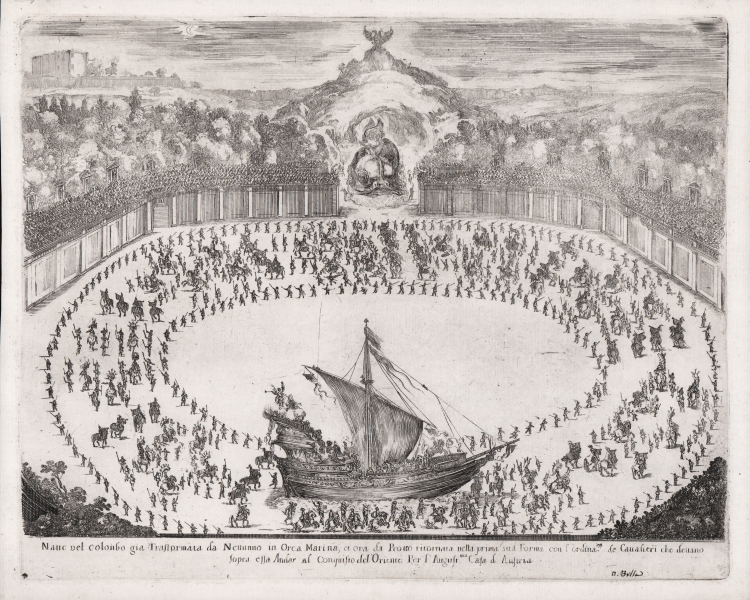




| Reference: | S5314 |
| Author | Stefano Della BELLA |
| Year: | 1652 ca. |
| Measures: | 395 x 240 mm |



| Reference: | S5314 |
| Author | Stefano Della BELLA |
| Year: | 1652 ca. |
| Measures: | 395 x 240 mm |
Etching, 1652, signed at lower right. After Alfonso Parigi. In lower margin: Naue del Colonbo gia trasformata da Nettunno in orca marina, et ora da Proteo ritornata nella prima sua forma con l'ordina.za de caualieri che deuano sopra essa andar al conquisto del Oriente per l'august.ma casa d'Austria
A fine impression, printed on contemporary laid paper with "three rocks" watermark (close to Lieure 4), with margins, perfect condition.
Ordered by Grand Duke Ferdinando II of Tuscany and conceived by Tommaso Guidoni, the ballet was performed in the amphitheater of the Boboli gardens. Alfonso Parigi designed the costumes, the decorations, and the float of Neptune. Ferdinando Tacca designed the float of the sea monster; Impressions of the etching were issued with Benedetto Rigogli's poem in verse in: Combattimento e balletto a cavallo rappresentato di notte in Fiorenza ... (In Fiorenza : Nella stamperia di S.A.S. alla Condotta, 1652).
The print depicts the horse ballet known as Proteo e Fama, performed in Florence on the evening of April 28, 1652 in honor of the visit of Anna de' Medici, Ferdinand Karl of Austria and Sigmund Franz of Austria; Infantrymen, torchbearers, and cavaliers are shown marching in the arena, escorting the ship of Christopher Columbus. In the background, a sea monster emerges from a mount adorned with a double-headed eagle; The etcher's signature is incomplete, with only the faint letters "D Bella" visible.
Unknown colection mark, on verso.
Stefano della Bella was one of the most interesting and original engravers in 17th-century Florence and can be considered the only brilliant continuator of Jacques Callot's work. His artistic education began in Florence in the workshop of the goldsmiths Gasparo Mola and Orazio Vanni, and the precision of sign, typical of the goldsmith's art, will remain characteristic of his style. He then studied under Giovanni Battista Vanni and perhaps also under Cantagallina and Cesare Dandini, but soon turned to engraving. His real master can be considered Jacques Callot, the French engraver who stayed in Florence for a long time and left a strong imprint on the city's artistic scene.
The most important years of his career were the ones he spent in Paris, from 1639 to 1650, salaried by Lorenzo de' Medici: he worked together with Israel Silvestre, with the publishers Langlois, Ciartres and Pierre Mariette, for French printers and for commissions of great prestige, such as those of 1641 for Cardinal Richelieu, who entrusted him with illustrations of his warlike exploits.
Around 1647, during a trip to Holland, where he executed etchings with views of the port of Amsterdam, he met Rembrandt, and from that date we note a profound echo of the Dutchman's art in Della Bella's graphic work.
Bibliografia
De Vesme - Massar Stefano della Bella (1971) n. 66; “Il luogo teatrale a Firenze” 11.7.
Stefano Della BELLA (Firenze 1610 - 1664)
|
Stefano della Bella was one of the most interesting and ingenious artists of XVII century in Florence and can be considered as the sole real follower of Callot. He was educated in Florence at first, in the studio of Gasparo Mola and Orazio Vanni; this experience gave him a firm and careful hand when using the graver. He then went to Giovan Battista Vanni’s and, very likely, he also studied with Cantagallina and Cesare Dandini but, as Baldinucci said, he was still very young when he decided to leave painting and devoute entirely himself to engraving. His real master, then, can be considered Jacques Callot, the French engraver who lived for long time in Florence spreading his influence all around the city.
Lorenzo dè Medici became soon Stefano’s patron and invited the young artist in Rome between 1633 and 1636; in the Eternal City, the artist realized many copies from the antiquities and from Polidoro’s works. In 1633 he realized his first noteworthy work: Entrata a Roma dell’ambasciatore di Polonia Giorgio Ossolinsky.
In 1639 Stefano went to Paris where he lived, until 1650, out of a pension Lorenzo dè Medici had granted to him.
Around 1647, when travelling along the Netherlands, he met Rembrandt; from that moment the influence of the Dutch artist can be found in the entire Della Bella’s production.
|
Stefano Della BELLA (Firenze 1610 - 1664)
|
Stefano della Bella was one of the most interesting and ingenious artists of XVII century in Florence and can be considered as the sole real follower of Callot. He was educated in Florence at first, in the studio of Gasparo Mola and Orazio Vanni; this experience gave him a firm and careful hand when using the graver. He then went to Giovan Battista Vanni’s and, very likely, he also studied with Cantagallina and Cesare Dandini but, as Baldinucci said, he was still very young when he decided to leave painting and devoute entirely himself to engraving. His real master, then, can be considered Jacques Callot, the French engraver who lived for long time in Florence spreading his influence all around the city.
Lorenzo dè Medici became soon Stefano’s patron and invited the young artist in Rome between 1633 and 1636; in the Eternal City, the artist realized many copies from the antiquities and from Polidoro’s works. In 1633 he realized his first noteworthy work: Entrata a Roma dell’ambasciatore di Polonia Giorgio Ossolinsky.
In 1639 Stefano went to Paris where he lived, until 1650, out of a pension Lorenzo dè Medici had granted to him.
Around 1647, when travelling along the Netherlands, he met Rembrandt; from that moment the influence of the Dutch artist can be found in the entire Della Bella’s production.
|